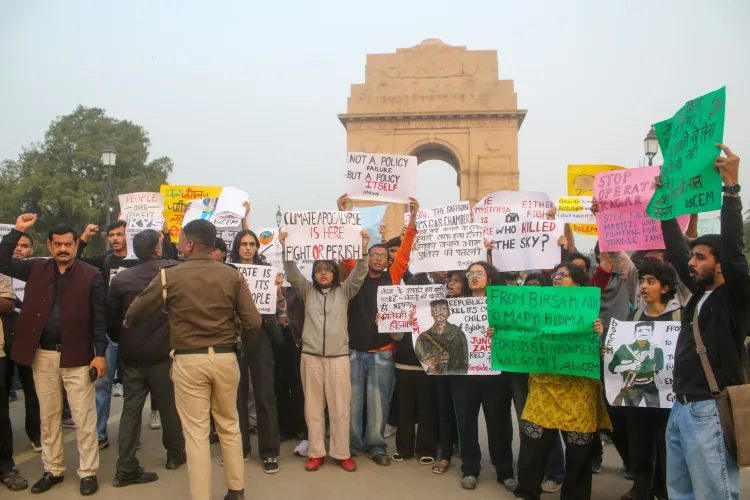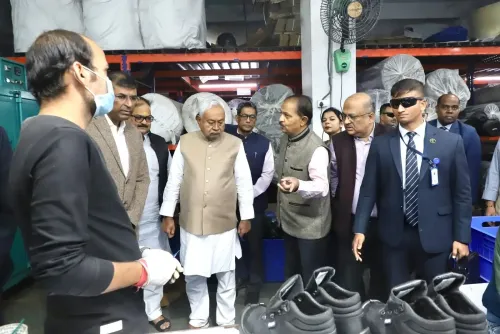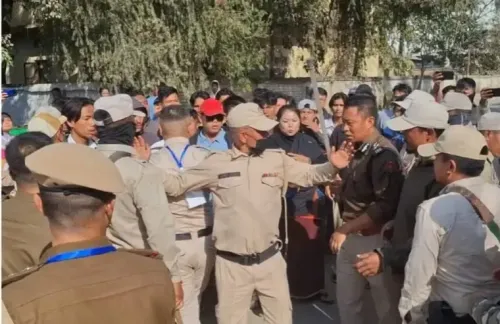Why Were 15 Individuals Detained During the Delhi Pollution Protests?

Synopsis
Key Takeaways
- 15 individuals detained during protests against pollution.
- The situation escalated as demonstrators ignored police warnings.
- Authorities are enforcing stricter pollution control measures.
- Air quality in Delhi continues to deteriorate.
- Health warnings issued due to toxic haze.
New Delhi, Nov 24 (NationPress) Authorities reported that students detained amid protests against escalating pollution in the Delhi-NCR area are currently at the Parliament Street Police Station for medical evaluations. The detentions occurred following a demonstration at the C-hexagon, where police apprehended 15 people after they reportedly ignored multiple dispersal warnings.
Officials indicated that an FIR has been filed under various sections, including those pertaining to hindering governmental operations. The Delhi Police confirmed the arrest of approximately 15 individuals, some taken from India Gate and others from near the Parliament Street police station.
It was alleged that the demonstrators employed pepper spray during the protest, which caused irritation to three to four police officers, necessitating hospital treatment.
According to reports, multiple protesters entered the C-hexagon area, attempting to breach barricades set up to manage movement. Law enforcement explained that ambulances and medical teams were stranded behind the blockade and required immediate access, but the protesters allegedly became agitated.
When it became clear that the situation could escalate, officers urged the protesters to retreat. However, according to officials, the group disregarded these instructions, breached the barricades, sat down on the road, prompting police action to restore order.
The group was escorted away from the C-hexagon to minimize further traffic disruption in this high-traffic area.
This incident follows previous detentions on November 9 at India Gate during a 'clean air protest', where participants called for immediate government intervention and stricter measures to combat what they termed an 'air emergency' in the national capital.
Protests have intensified as visibility worsens across various parts of the city due to the thickening toxic haze, leading to renewed health warnings from officials.
Surrounding NCR cities are also facing deteriorating air quality, with Faridabad reporting an AQI of 358, Gurugram 370, Ghaziabad 355, Greater Noida 342, and Noida 372.
While most areas in Delhi are experiencing AQI levels between 300 and 400, certain pockets have surpassed the 400 threshold, entering the 'severe' category. Officials caution that conditions may deteriorate further if wind speeds remain low.
In response to rising pollution levels, the Commission for Air Quality Management for NCR and neighboring regions adjusted the Graded Response Action Plan on Saturday.
In a recent press statement, the CAQM announced that measures previously reserved for the 'severe' category under GRAP Stage IV will now be applied at Stage III.
These measures include ensuring uninterrupted power supply to decrease diesel generator usage, deploying additional personnel at traffic congestion hotspots, issuing pollution alerts through media channels, and expanding CNG and electric public transport fleets with increased service frequency and differential fares to encourage off-peak travel.
Several strategies that were initially categorized as Stage III for the 'very poor' air quality level have been moved to Stage II. This includes staggered working hours for government offices in Delhi, Gurugram, Faridabad, Ghaziabad, and Gautam Buddh Nagar.
The central government may also contemplate staggered timings for its offices in the region.
Restrictions that were previously applicable only during Stage IV for severe AQI, such as limiting public, municipal, and private offices to operate with only 50% of staff and allowing the remaining workforce to work from home, will now be enforced at Stage III.
Meanwhile, the Delhi government has mandated that private offices function with 50% on-site employees and permit the rest to telecommute as a precautionary step, as the capital continues to battle worsening air quality.









